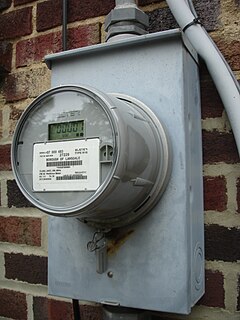Customer relationship management (CRM) is a process in which a business or other organization administers its interactions with customers, typically using data analysis to study large amounts of information.
In telecommunication, provisioning involves the process of preparing and equipping a network to allow it to provide new services to its users. In National Security/Emergency Preparedness telecommunications services, "provisioning" equates to "initiation" and includes altering the state of an existing priority service or capability.

The point of sale (POS) or point of purchase (POP) is the time and place where a retail transaction is completed. At the point of sale, the merchant calculates the amount owed by the customer, indicates that amount, may prepare an invoice for the customer, and indicates the options for the customer to make payment. It is also the point at which a customer makes a payment to the merchant in exchange for goods or after provision of a service. After receiving payment, the merchant may issue a receipt for the transaction, which is usually printed but can also be dispensed with or sent electronically.
A distributed control system (DCS) is a computerised control system for a process or plant usually with many control loops, in which autonomous controllers are distributed throughout the system, but there is no central operator supervisory control. This is in contrast to systems that use centralized controllers; either discrete controllers located at a central control room or within a central computer. The DCS concept increases reliability and reduces installation costs by localising control functions near the process plant, with remote monitoring and supervision.
Salesforce management systems are information systems used in customer relationship management (CRM) marketing and management that help automate some sales and sales force management functions. They are often combined with a marketing information system, in which case they are often called CRM systems.

Automatic meter reading (AMR) is the technology of automatically collecting consumption, diagnostic, and status data from water meter or energy metering devices and transferring that data to a central database for billing, troubleshooting, and analyzing. This technology mainly saves utility providers the expense of periodic trips to each physical location to read a meter. Another advantage is that billing can be based on near real-time consumption rather than on estimates based on past or predicted consumption. This timely information coupled with analysis can help both utility providers and customers better control the use and production of electric energy, gas usage, or water consumption.

Telematics is an interdisciplinary field that encompasses telecommunications, vehicular technologies, electrical engineering, and computer science. Telematics can involve any of the following:
Field service management (FSM) refers to the management of a company's resources employed at or en route to the property of clients, rather than on company property. Examples include locating vehicles, managing worker activity, scheduling and dispatching work, ensuring driver safety, and integrating the management of such activities with inventory, billing, accounting and other back-office systems. FSM most commonly refers to companies who need to manage installation, service, or repairs of systems or equipment. It can also refer to software and cloud-based platforms that aid in field service management.
Enterprise feedback management (EFM) is a system of processes and software that enables organizations to centrally manage deployment of surveys while dispersing authoring and analysis throughout an organization. EFM systems typically provide different roles and permission levels for different types of users, such as novice survey authors, professional survey authors, survey reporters and translators. EFM can help an organization establish a dialogue with employees, partners, and customers regarding key issues and concerns and potentially make customer-specific real time interventions. EFM consists of data collection, analysis and reporting.
Machine to machine (M2M) is direct communication between devices using any communications channel, including wired and wireless. Machine to machine communication can include industrial instrumentation, enabling a sensor or meter to communicate the information it records to application software that can use it. Such communication was originally accomplished by having a remote network of machines relay information back to a central hub for analysis, which would then be rerouted into a system like a personal computer.

A queue management system is used to control queues. Queues of people form in various situations and locations in a queue area. The process of queue formation and propagation is defined as queuing theory.
A mobile enterprise is a corporation or large organization that supports critical business functions and use of business applications via remote work using wireless mobile devices. In a mobile enterprise, employees use mobile devices to do any or all of the following: access email, manage projects, manage documents, provide customer relationship management, conduct enterprise resource planning, fill out invoices and receipts, accounting vouchers, work orders, purchase orders, etc. and manage a corporate calendar and address book. These are the most common applications though many other corporate mobile applications are being developed and used by organizations around the world.
A vehicle tracking system combines the use of automatic vehicle location in individual vehicles with software that collects these fleet data for a comprehensive picture of vehicle locations. Modern vehicle tracking systems commonly use GPS or GLONASS technology for locating the vehicle, but other types of automatic vehicle location technology can also be used. Vehicle information can be viewed on electronic maps via the Internet or specialized software. Urban public transit authorities are an increasingly common user of vehicle tracking systems, particularly in large cities.

Mobile technology is the technology used for cellular communication. Mobile technology has evolved rapidly over the past few years. Since the start of this millennium, a standard mobile device has gone from being no more than a simple two-way pager to being a mobile phone, GPS navigation device, an embedded web browser and instant messaging client, and a handheld gaming console. Many experts believe that the future of computer technology rests in mobile computing with wireless networking. Mobile computing by way of tablet computers is becoming more popular. Tablets are available on the 3G and 4G networks. Mobile technology has different meanings in different aspects, mainly mobile technology in information technology and mobile technology in basketball technology, mainly based on the wireless technology of wireless devices equipment information technology integration.
Wireless Expense Management (WEM) is an extension of Telecom Expense Management (TEM) services and is the process of managing enterprise's mobile and wireless devices. However, not only auditing invoices are enough to fully manage the device from procurement to retirement. Corporations need to be able to focus on their core business; the larger the business, the more there is to handle on a day-to-day basis. Businesses with a large mobile/cellular/wireless presence also have the expenses associated with them. These companies need professional Telecom Expense Management (TEM) to help them manage their wireless telecom bills accurately and effectively.
Mobile enterprise asset management refers to the mobile extension of work processes for maintenance, operations and repair of corporate or public-entity physical assets, equipment, buildings and grounds. It involves management of work orders via communication between a mobilized workforce and computer systems to maintain an organization's facilities, structures and other assets.
A connected car is a car that can communicate bidirectionally with other systems outside of the car (LAN). This allows the car to share internet access, and hence data, with other devices both inside and outside the vehicle. For safety-critical applications, it is anticipated that cars will also be connected using dedicated short-range communications (DSRC) or cellular radios, operating in the FCC-granted 5.9 GHz band with very low latency.
Cisco Prime is a network management software suite consisting of different software applications by Cisco Systems. Most applications are geared towards either Enterprise or Service Provider networks. There is Cisco Network Registrar among those.
Mobile location analytics (MLA) is a type of customer intelligence and refers to technology for retailers, including developing aggregate reports used to reduce waiting times at checkouts, improving store layouts, and understanding consumer shopping patterns. The reports are generated by recognizing the Wi-Fi or Bluetooth addresses of cell phones as they interact with store networks.
In marketing, contact center telephony is the communication and collaboration system used by businesses to either manage high volumes of inbound queries or outbound telephone calls keeping their workforce or agents productive and in control to serve or acquire customers. This business communication system is an extension of computer telephony integration (CTI).




